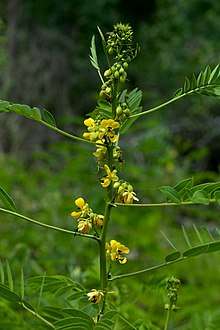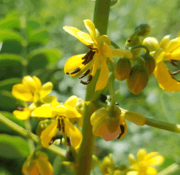Senna marilandica
Senna marilandica, the Maryland senna[2] or Maryland wild senna, is a perennial flowering plant in the United States that blooms in the summer and can grow up to six feet tall. It prefers average to wet soil, and is native in the southeast, all the way to the southern Great Lakes.[3]
| Senna marilandica | |
|---|---|
 | |
| Scientific classification | |
| Kingdom: | Plantae |
| Clade: | Tracheophytes |
| Clade: | Angiosperms |
| Clade: | Eudicots |
| Clade: | Rosids |
| Order: | Fabales |
| Family: | Fabaceae |
| Genus: | Senna |
| Species: | S. marilandica |
| Binomial name | |
| Senna marilandica (L.) Link (1831, as "marylandica") | |
| Synonyms[1] | |
|
Synonyms
| |
It is a larval host to the cloudless sulphur (Phoebis sennae), orange-barred sulphur (Phoebis philea), and sleepy orange (Eurema nicippe) butterflies.[4]

_along_the_Cacapon_River.jpg) Senna marilandica on the banks of the Cacapon River
Senna marilandica on the banks of the Cacapon River
References
- "Senna marilandica (L.) Link". Plants of the World Online. Royal Botanic Gardens, Kew. Retrieved 29 December 2019.
- "Senna marilandica". Natural Resources Conservation Service PLANTS Database. USDA. Retrieved 10 November 2015.
- "Senna marilandica". County-level distribution map from the North American Plant Atlas (NAPA). Biota of North America Program (BONAP). 2019.
- The Xerces Society (2016), Gardening for Butterflies: How You Can Attract and Protect Beautiful, Beneficial Insects, Timber Press.
This article is issued from Wikipedia. The text is licensed under Creative Commons - Attribution - Sharealike. Additional terms may apply for the media files.